Fesenjan or Fesenjoon is simply one of the wonders of Persian cuisine! The dish may be described as one of the most delicious, nutritious, comforting and elegant dishes anyone can try in their lifetime, and this is no exaggeration. The sweet and sour taste of pomegranate molasses, silky texture of ground walnut and the magnificent odour of Fesenjan will take one to the heart of northern Iran, Gilan. The dish is also a popular accompany in Iranian special occasions such as parties and weddings. Only one spoon of this jewelled stew brings layers of flavours to your mouth at once.
ABOUT FESENJAN
For me, Fesenjoon is a reminder of my grandmother’s house in northern Iran where the whole family used to gather to prepare Khoresht-e Fesenjan (Fesenjan Stew in Farsi) from scratch. As kids playing in the backyard around the pomegranate trees, we would come inside the house to a pleasant smell of Fesenjan and saffron rice. We would help our parents and witness the making of Fesenjoon for the family feast. In fact, Fesenjoon has originated from northern parts of Iran, Gilan, along the Caspian Sea where the sour pomegranate trees grow. Even though Fesenjoon originates from Gilan but it has found its way through all the cities in Iran with minimal variation in the recipe.
Fesenjoon stew contains pomegranate molasses and walnuts in addition to a protein, but there is so much more to this tangy and sweet dish. The pomegranate molasses which is responsible for the sour and sweet taste of Fesenjann is not a common ingredient in the supermarkets outside Iran. Pomegranate fruit could be sweet or sour depending on the climate it is growing in Iran. This is why pomegranate molasses made out of fresh pomegranates could vary from sour (dark brown) to sweet (light brown) as you move from the northern part of the country to the hotter climates in the south. Persians like Fesenjan to be more on the sour taste but in some recipes, sugar is also added to add that extra sweet taste.
As described above Persians have a special place for pomegranate (“Anar” in Farsi) in their heart. Pomegranate is known as the heavenly fruit on earth in Iranian culture. Pomegranate along with watermelon is a symbol of Persian winter solstice celebrations such as “Yalda” which is the longest night of the year! The love for this fruit has made Persians to make pomegranate molasses by cooking down pomegranate juice in a pot until it thickens and reduced to a brown paste. If you cannot buy it from supermarkets you can simply make it at home.
Check our recipe for Ash-e Anar | Persian Pomegranate soup
Cooking Fesenjan might seem very hard by its long-time of simmering, but it is one of the simplest dishes in Iranian cuisine. While everything is cooking you can sit back and let the pot to bubble gently and for the walnuts to release their magnificent odour and oil. Don’t forget that like every other stew in Persian cuisine this food is also served with rice, this time saffron rice.
VEGETARIAN FESENJAN
Fesenjan has over three variations depending on the protein. Traditionally it was made with duck or turkey, but nowadays it is more common with chicken and meatballs. For a vegetarian option, the protein could be replaced with anything such as grilled tofu, grilled eggplant, or roasted squash. As long as the two main ingredients of pomegranate molasses and walnut paste are in the pot you won’t have any problems in making Fesenjoon.
FESENJAN RECIPE INGREDIENTS
- 1 Large onion chopped fine
- 3-4 tbsp Vegetable oil
- 1 cup Pomegranate molasses (plus extra as needed)
- 4-5 pieces Chicken breast or skinless, boneless thigh
- 2-3 cups Coldwater
- 2 cups Walnut halves
- 1 tsp of Turmeric
- Salt and Pepper
- 8-10 Crushed Ice pieces
- 2 tbsp Sugar (Optional)
- 4 tbsp Bloomed saffron (optional)

HOW TO MAKE FESENJAN WITH CHICKEN
- Fesenjoon is served with saffron rice. For making saffron rice refer to this post.
- Using a food processor chop the fresh walnuts until you have a creamy beige paste of walnuts.

- In a large pot over medium heat add one tablespoon of oil and add the chopped onions. To create a rich base for the stew sautée the onions until light. Remember the walnut will later release the oil, therefore don’t add too much oil to the pan.
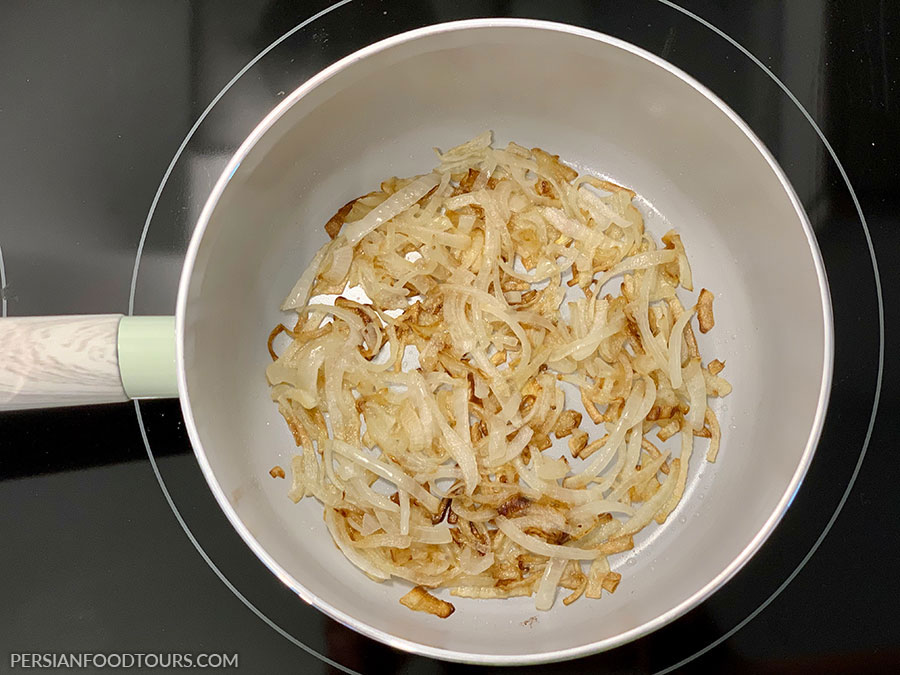
- In a pan, add a small amount of oil over medium heat. Spice the chicken breast cut into pieces with salt, pepper, and turmeric. Fry the chicken on both sides and let aside. Instead of chicken, you can either prepare meatballs or any vegetarian protein such as tofu, eggplants, or roasted squash for a vegetarian Fesenjoon.
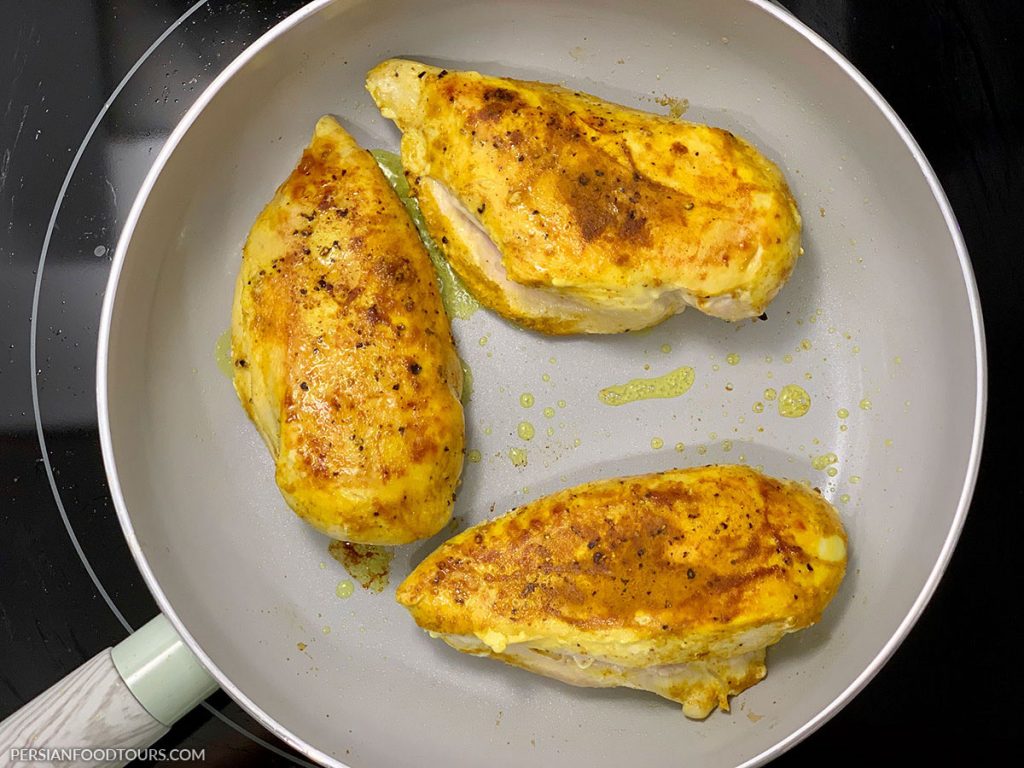
- In the first pot, add the crushed walnut and stir for one minute until the walnuts get tender.
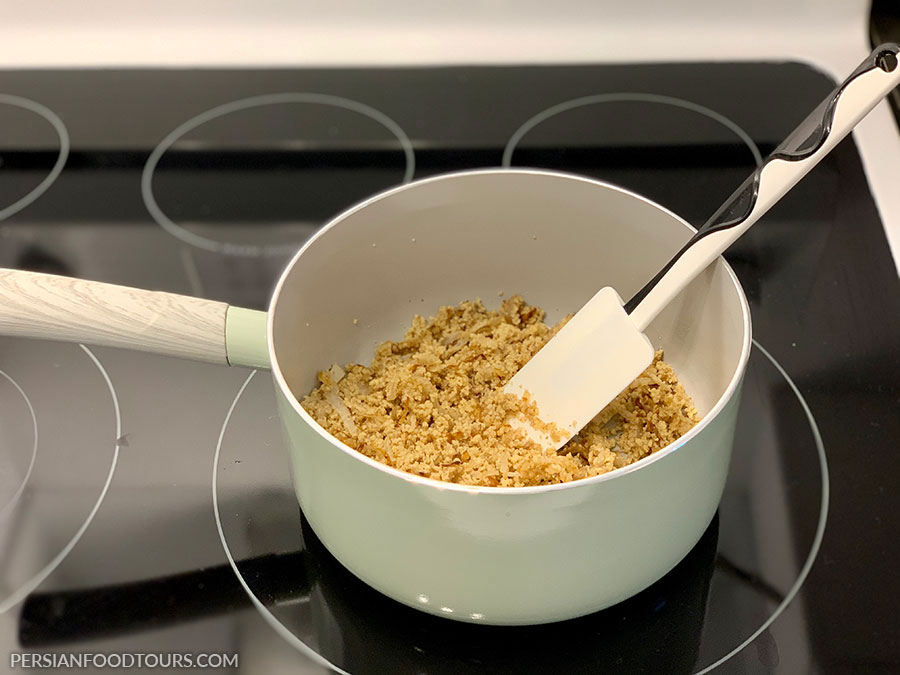
- Add 1 cup of pomegranate molasses. If you cannot find molasses in the supermarket, just make homemade pomegranate molasses by cooking down the pomegranate juice in a pan for about an hour until it thickens to a brown paste. The leftovers can be easily stored in a refrigerator.
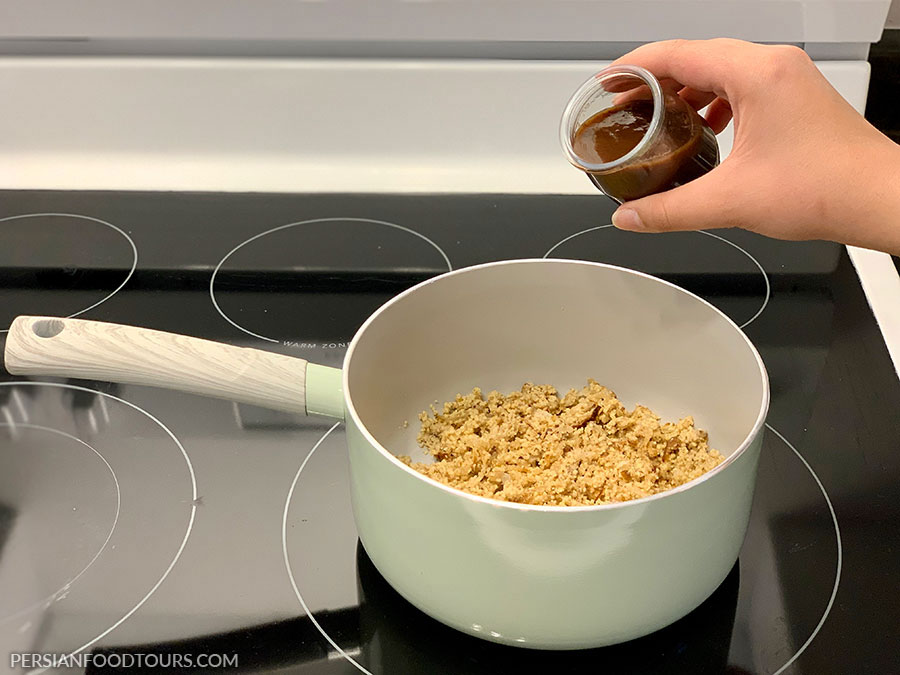
- Then simply add 2 cups of cold water to the pot. The cold water helps to bring out the walnut oil and flavour. Let the stew to boil over medium heat and bring down the heat to medium-low.
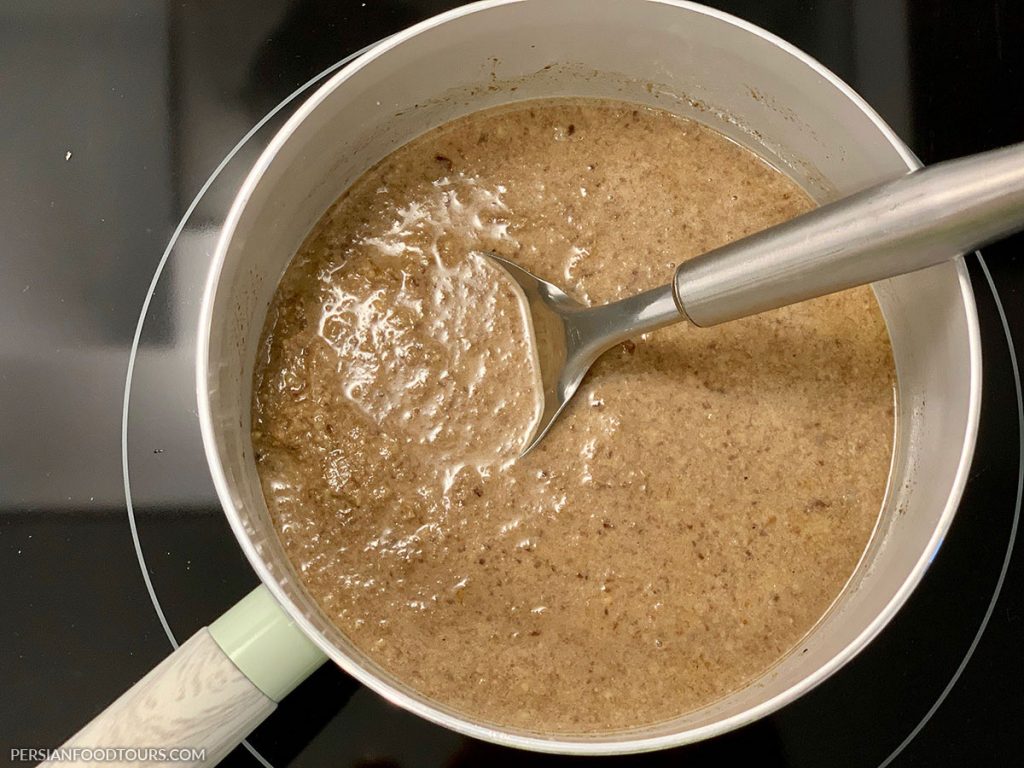
- Cover the pot and let it simmer for at least an hour and half over medium-low heat.
- One grandma tip in cooking Fesenjan would be to add small pieces of crushed ice once in a while to help walnut to release its oil.
- Stir the stew occasionally and add a small amount of water or crushed ice to prevent it from sticking to the pot. The stew should be thick, but it should not stick to the pot.
- After an hour and half of simmering on medium-low heat, add the chicken to the pot.
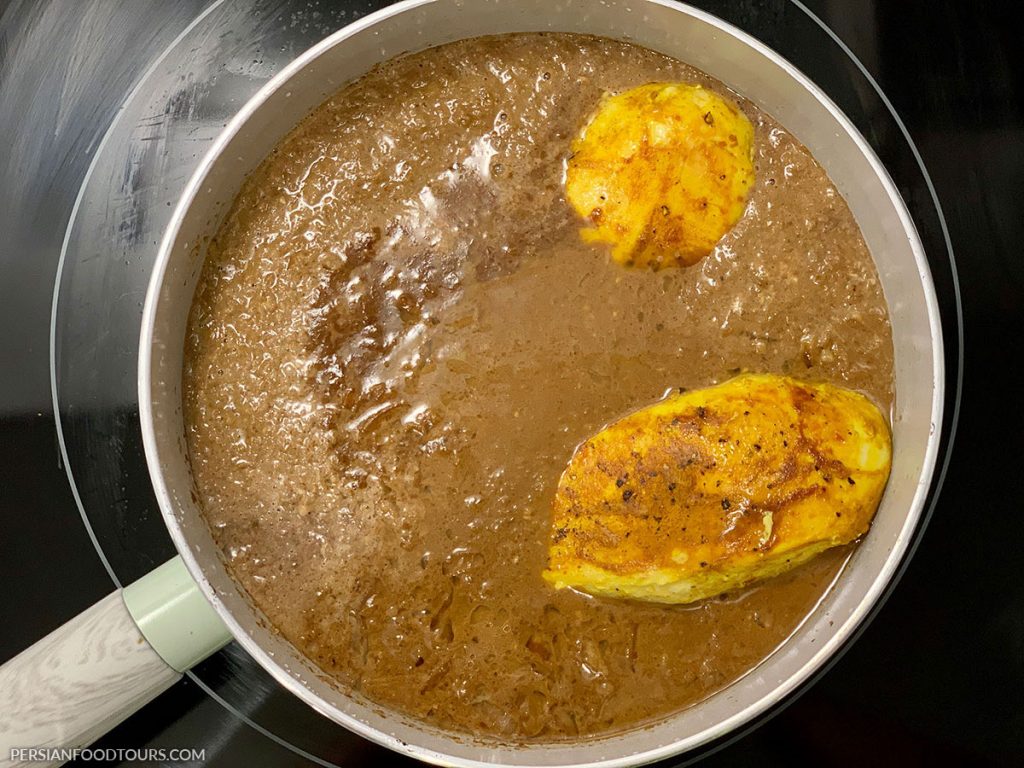
- Let the stew to simmer for 1 more hour and meanwhile stir the pot and add a small amount of water or crushed ice to the pot.
- Taste and adjust the seasoning. If it is too sour for you, just add two tablespoons of sugar for more sweetness. The stew will turn into a really dark brown color as it simmers due to the presence of pomegranate molasses and the walnut oil gently bubbles up to lie on the top of the pan. This is when you know the Fesenjan is ready to serve.
HOW TO SERVE FESENJOON
Remove your food from the heat. Pour the Fesenjan to a large serving bowl. Drizzle pomegranate seeds and walnuts on top to garnish. Enjoy it over saffron rice with a side of baby onions and radishes along with a great Persian refreshment to complete the feast!

SLOW COOKER FESENJAN
Fesenjan is a slow cook stew and it makes it a perfect recipe for your slow cooker. If you own a slow cooker you should give this recipe a try! You can simply fry the onions and spiced chicken until both sides of the chicken are golden. Once the onion and chicken are ready you can add all the Fesenjan ingredients in your slow cooker at once and set it on high for 4-6 hours to come home to a pleasant smell of Fesenjan! Bon Appetit!
FESENJAN RECIPE NOTES
- Find pomegranate molasses at the Middle Eastern stores or specialty food stores.
- For a vegetarian Fesenjan, grill the vegetable protein and add it just before serving to prevent the disintegration of the protein.
- Don’t overheat the walnut paste as you don’t want any burns. This can make Fesenjan taste bitter.
- If you are adding meatballs instead of chicken, prepare your meatballs and add them 15 minutes prior to turning off the heat.
- Make sure to not overcook the chicken as it can easily fall apart in your Fesenjoon.
- Fesenjoon should be thick and silky, stir occasionally while adding two 1/8 cup of water or small pieces of crushed ice.
- At the very end, you can add your optional ingredient: the steeped saffron in boiling water (blooming saffron). This adds to the pleasant odour of this dish. However, saffron is not used as the main ingredient in many recipes.
- The pomegranate molasses sweetness could vary depending on the brand. One cup is suggested, but you can adjust the taste of sourness by adding more.
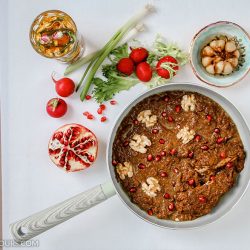
Fesenjan
Ingredients
Stew
- 2 cups Walnuts
- 1 cup Pomegranate molasses
- 1 cup Cooked butternut squash
- 8 Dried golden plums
- 1/4 cup Sugar Plus more if needed
- Water
Chicken
- 4 Boneless, skinless chicken breasts
- 1/4 cup Bloomed Saffron
- 1 Large Onion Thinly sliced
- 1 tsp Turmeric powder
- 1 tsp Cardamom powder
- 1 tsp Cinnamon powder
- 1 cup Water
- Vegetable oil
- Salt and pepper to taste
Instructions
Chicken
- 1. Season the chicken with turmeric, cardamom, cinnamon, saffron, salt, and pepper. 2. In an ovenproof dish place, the onion and chicken then cover the top with aluminium foil and cook in the oven for 45 minutes.
Stew
- 1. Heat the oven to 200. Spread the walnuts into an even layer and bake until toasted, about 15 minutes. Remove from the oven and cool completely. 2. Meanwhile, cook the dried plums in half a cup of water, until the seeds can be removed, remove from the heat and set a side. 3. Transfer the walnuts to a food processor. Purée until well ground until they have the consistency of peanut butter and the walnut crumbs are starting to stick together like a dough. 4. Add the pomegranate molasses, cooked butternut squash, cooked plums into the food processor mix well, adding about 2 cups of water little by little. 5. Transfer the mixture into a large, lidded pot. Bring it to boil for 4–5 minutes, then reduce the heat until the mixture is simmering. 6. Simmer the walnut mixture, half-covered with the casserole lid, for 1 hour on a low heat. Stir occasionally throughout to make sure the walnuts don’t stick to the bottom of the pot. (This mixture tends to stick and burn fairly quickly so avoid high heat) 7. Season to taste, Add 1 tablespoon of sugar at a time, mix well. Taste and add more sugar (for sweet) or pomegranate molasses (for sour). fesenjoon is a well-balanced, sweet and sour (malas) dish. 8. After 1 hour, the walnut sauce should have thickened and darkened in colour, rich and creamy. 9. If fesenjoon is too watery and not of a thick consistency leave the cover a little ajar, to let the steam and moisture out and simmer more until it thickens. Fesenjoon should not be watery.Transfer the stew in to a serving dish place the chicken on top and sprinkle some pomegranate arils for garnish.Serve hot with Chelow ( persian steamed rice)





Customer
4 Add chicken and stock: Return the chicken pieces to the pan with the onions. Pour 2 cups of chicken stock over the chicken and onions. Bring to a boil, reduce to a simmer, cover and simmer gently for 30 minutes.